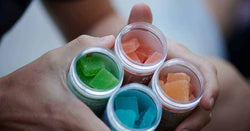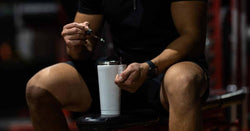 uncategorized
uncategorizedWhat Is Arnica? Does It Really Work?
Arnica is one of those herbs that a lot of people have heard of, but might not know what it is, where it comes from, or what exactly it's used for.
Arnica montana is a perennial flowering plant native to Europe and North America used for centuries as a herbal remedy. The yellow, daisy-like flower contains a number of flavonoids and terpenes thought to be beneficial for the skin and is commonly used to treat bruises and muscle soreness, but it's also used as a homeopathic remedy, taken internally.
In this post, we'll take a closer look at the benefits of arnica oil and provide some tips on how to use it safely. Stay tuned!
Article Highlights:
- Arnica Montana is a mountain flower that has a long history of use as an herbal remedy for bruises, scars, and muscle soreness.
- One of the main active ingredients in arnica is helenalin, which is found to have anti-inflammatory and pain-relieving effects on the skin.
- While applying arnica gel and lotions is generally safe and well-tolerated, consuming the Arnica Montana plant and extracts can be extremely dangerous.
- Consuming homeopathic Arnica Montana products are also quite safe as homeopathic products contain very diluted forms of arnica.
- Cannabidiol (CBD) and arnica are an excellent pairing when used topically as they have similar properties to support the body's natural healing abilities.
Topical Arnica Plant Benefits & Uses
According to folklore, the arnica flower is an effective treatment for a wide variety of ailments, ranging from bruises, muscle aches, and sprains to arthritis and gout.
The active ingredients in arnica are thought to be compounds called sesquiterpene lactones such as helenalin, 11α,13-dihydrohelenalin, and chamissonolid, which have both anti-inflammatory and analgesic properties [1].
Helenalin works by reducing inflammation by inhibiting a protein complex that creates cytokines (inflammatory markers) [1].
Additionally, studies have shown that arnica can help to reduce swelling and bruising just as well as over-the-counter anti-inflammatories such as ibuprofen, making it an ideal natural remedy for joint pain and muscle aches [2, 3].
While more research is needed to confirm the efficacy of Arnica Montana, arnica ointments, gels, and rubs have become a favorite among athletes and have become a household staple in many families' medicine cabinets for bruises and muscle pain.
Benefit Of Combining CBD & Arnica Extract In Topicals
Cannabidiol (CBD) and arnica are two natural ingredients that have long been used to support muscle pain and soreness. Both plant-derived compounds are shown to have anti-inflammatory and analgesic properties, making them ideal for use in topicals [4].
When combined, arnica and CBD topicals can provide a gentle yet powerful synergistic effect that may help to soothe muscle pain and soreness. Moreover, CBD-arnica topicals are safe to use and are typically well-tolerated by most people.
The biggest issue in finding a quality CBD topical is the potency.
If you're using a CBD topical product and not seeing any results, there's a good chance that it doesn't contain enough CBD. There are a lot of subpar products on the market that don't contain enough CBD to produce any effects. You might as well apply regular body lotion— it would probably have the same results.
There are a lot of products out there claim to be "high potency", but they really aren't. A high potency CBD topical can make all the difference when it comes to effectiveness.
That's why it's important to make sure you're using a high potency CBD topical containing at least 10 mg of CBD per mL of product. The only way to be sure you're getting a high-potency product is to check the certificate of analysis (COA).
This is a document that shows the exact amount of CBD in the product. If a company can't provide a COA, consider it a red flag. You should also be suspicious of companies that don't list the potency on their website or packaging.
What Are The Benefits Of Topical CBD
One of the major advantages of CBD is that it can be applied directly to the skin, either as a lotion or salve.
Applying CBD to the skin means it doesn't enter the bloodstream to disperse effects throughout the body, instead, the cannabinoids are concentrated on the affected areas offering more support to the endocannabinoid receptors present in the skin tissue for potent and fast-acting relief from soreness.
Whether you need relief from muscle aches after a long run or just want your skin to look and feel healthier, topical CBD is definitely worth trying.
VIIA CBD Roll-On With Arnica
The VIIA Roll-On was inspired by these two powerful botanicals. Arnica is a potent natural anti-inflammatory that has been shown in numerous studies to be effective at relieving pain from both extreme and repetitive physical activity and external injuries such as sprains or bruises.
In fact, arnica works so well at soothing sore muscles that athletes often use it after long periods of exercise or during heavy training sessions to prevent fatigue and reduce tissue damage.
The Roll-On features arnica-infused sunflower oil combined with full-spectrum CBD (1000 mg), making it a potent CBD topical.
But potency is only as good as the quality of the hemp source. All VIIA products are grown and extracted from organic outdoor hemp farms in central Oregon and quality tested in every stage of production.
Whether you're dealing with tired muscles, aching joints, or just need some soothing relief, these roll-ons make it easy to apply CBD right where you need it. And thanks to its handy acupressure rollerball design, you can massage your skin while keeping the product away from your hands and clothing.
The Cool Roller provides a cooling sensation to relieve pain with organic methanol crystals and botanicals (Organic Calendula Flowers, Organic Comfrey Leaf, Organic St. John's Wort).
For tension and stress, the Calm Roller is the best option. It's lemongrass and lavender-scented and 7 botanical herbs traditionally used to reduce pain and condition the skin.
How To Use The VIIA CBD Roll-On Topicals

The VIIA Roll-Ons come with an acupressure roller ball for a mess-free massage application.
The principle behind acupressure is that points on the body are connected by energy pathways or meridians. When these pathways become blocked, it can lead to pain or illness. Applying gentle pressure to specific points can unblock the energy flow and improve circulation to promote healing.
While acupressure is often used to relieve pain, it can also be used for various other purposes, including stress relief, improved circulation, and overall relaxation.
Only apply the CBD roll-on to clean, dry, unbroken skin and massage gently. You can use it multiple times a day as needed on muscles, joints, and temples. Because the formula dries quickly and is non-greasy, it can easily be used before or after physical activity without running the risk of staining your clothing or leaving behind an unpleasant residue.
Homeopathic Arnica Montana
While the arnica flowers contain compounds to support arthritic pain, bruising, and muscle soreness in topical herbal remedies, there isn't as much evidence to show that oral arnica has the same benefits. But still, you'll find that homeopathic arnica therapy is viral in the wellness space at health food stores.
Arnica Montana is a poisonous herb when consumed orally, but homeopathic formulations of Arnica Montana are made by repeatedly diluting the active substance in water or alcohol.
The dilution process is believed to increase the potency of the remedy. However, there's no scientific evidence to support this claim. In fact, most homeopathic remedies are so diluted that they no longer contain any of the original active ingredients.
For this reason, some experts believe that homeopathic arnica remedies are nothing more than a placebo. Nevertheless, millions of people around the world swear by homeopathic products.
Precautions & Safety
Pure arnica has toxic effects. However, this is only a concern with oral arnica preparations or using the raw flower. Homeopathic doses of arnica are generally safe for use because they're very diluted, as long as they're taken as indicated on the product packaging.
The very same lactone known as helenalin that can calm inflammation is poisonous when ingested, causing vomiting, diarrhea, tremors, liver damage, and death when consumed in large amounts.
Most people can use topical arnica gels and oils safely. But even arnica gel and creams can be dangerous when they're not used as directed.
Don't use arnica topically on open wounds or broken skin, as it can cause further irritation.
Like any topical creams with active ingredients, some people may experience an allergic reaction, so testing a small patch on your skin before applying it to larger areas is essential.
Possible Side Effects
While arnica is generally safe when used as directed, there are a few possible side effects to be aware of. For instance, arnica can cause skin irritation when applied topically as it's a potent ingredient. If you notice any redness, swelling, or itchiness, discontinue use and consult your doctor. Arnica is also NOT for internal use— doing so can lead to vomiting, diarrhea, and other unpleasant gastrointestinal symptoms.
Finally, people with allergies to plants in the daisy family (including Ragweed) should avoid arnica altogether, as it may cause an allergic reaction. So if you're thinking of trying arnica, be sure to proceed with caution—and maybe give a patch test a go first.
Contraindications And Interactions (With Oral Arnica Supplements Only)
Though often used in small doses in homeopathic remedies, Arnica Montana should not be taken orally by pregnant women, as it can cause uterine contractions. People with high blood pressure should also avoid oral consumption of arnica, as it can act as a stimulant. If you are taking blood thinner medication, do not take arnica orally.
In addition, people with gastrointestinal disorders such as ulcers should avoid arnica, as it can irritate the digestive system. If you are considering taking arnica supplements, talk to your doctor first to make sure it is safe for you.
Final Thoughts: What Is Arnica? Benefits Of Topical Arnica
Arnica is a plant that has been used medicinally for centuries. Today, many people still use it as a natural remedy for pain, inflammation, and bruising.
Arnica is available in various forms, including gels, creams, ointments, and tinctures. It can be applied topically or taken internally (in homeopathic preparations). Some people also combine arnica with CBD to maximize its potential healing properties.
The VIIA Roll-On Topicals combine powerful arnica extract and full-spectrum CBD extract for the most potent roll-on on the market.
While there is some scientific evidence to support arnica for pain relief, more research is needed. For the most part, arnica is powerful yet gentle enough to use without any issues on the skin. However, if you're considering using arnica internally, consult with your healthcare provider first.
And as always, if you experience any adverse effects, stop using it immediately and see your doctor. We hope this article has helped you learn more about arnica and its potential benefits.
Resources Cited:
- Lyss, G., Schmidt, T. J., Merfort, I., & Pahl, H. L. (1997). Helenalin, an anti-inflammatory sesquiterpene lactone from Arnica, selectively inhibits transcription factor NF-κB. Biological chemistry, 378(9), 951-962.
- Pumpa, K. L., Fallon, K. E., Bensoussan, A., & Papalia, S. (2014). The effects of topical Arnica on performance, pain and muscle damage after intense eccentric exercise. European journal of sport science, 14(3), 294-300.
- Widrig, R., Suter, A., Saller, R., & Melzer, J. (2007). Choosing between NSAID and arnica for topical treatment of hand osteoarthritis in a randomised, double-blind study. Rheumatology international, 27(6), 585-591.
- Baswan, S. M., Klosner, A. E., Glynn, K., Rajgopal, A., Malik, K., Yim, S., & Stern, N. (2020). Therapeutic potential of cannabidiol (CBD) for skin health and disorders. Clinical, cosmetic and investigational dermatology, 13, 927.








